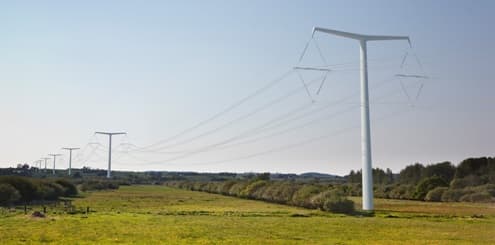Electricity Pylons Get A Makeover In The United Kingdom With The T-Pylon
Electricity Pylons have been with us since eternity. Their lattice structure made out of steel with four legs is immediately recognisable from miles. They are responsible for supporting overhead power lines that carry high voltages across a region. The humble and extremely useful electricity pylon has gotten a much needed makeover in the countryside of the United Kingdom. The National Grid, which is responsible for power transmission in the United Kingdom, has debuted the new T-Pylon in Nottinghamshire. The T-Pylon, as the name suggests has a single monocle structure that has two arms on each side that support power cables in a diamond arrangement. T-Pylons are of four types, suspension, flying angle, tension and dead-end pylon. The suspension T-Pylon is the most common pylon in an arrangement because it carries power lines in a straight line. The flying-angle T-Pylon is used when the grid has to turn an angle of less than 10 degrees. Tension T-Pylons are used when there is an angle of up to 30 degrees. You can distinguish between a tension T-Pylon from a suspension T-Pylon from its central frame that connects both diamond shaped structures. Finally we have the dead-end terminal pylon that can be seen on each end of the electricity grid, once at the source and other at the destination.

Types of T-Pylons
Apart from the obvious reduction in footprint as compared to traditional lattice-style electricity pylons, these new T-Pylons are 30% smaller (35 metres / 114 feet) and they help in reducing electro-magnetic field (EMF) radiation. T-Pylons can be installed quicker as they have fewer parts and are less complex than lattice electricity pylons. While it takes days to install a normal pylon, T-Pylon can be erected in hours. These T-Pylons have also managed to preserve the pristine look of the English countryside. The T-Pylon design was created by a Danish architects company called Bystrup for a an international competition held in 2011 by the Department of Energy and Climate Change (DECC) alongside the Royal Institute of British Architects (RIBA) and National Grid who were looking for a radical redesign of electricity pylons.

The National Grid informs us that T-Pylons will be used to carry electricity from non-conventional sources of energy like wind and nuclear. They make it clear that these new pylons will not eliminate conventional pylons and will work alongside them. The pylons are being erected on a testing basis at the Eakring training academy in Nottinghamshire. The installation work is expected to end by mid-April after which the stringing of pylons can begin.
For more information about the T-Pylons you can refer to the official press releases from #-Link-Snipped-# #-Link-Snipped-#, #-Link-Snipped-# and its coverage on the First new pylon type constructed - BBC News. If you are running short of time, you can click on the 8-minute video below.

Types of T-Pylons
Apart from the obvious reduction in footprint as compared to traditional lattice-style electricity pylons, these new T-Pylons are 30% smaller (35 metres / 114 feet) and they help in reducing electro-magnetic field (EMF) radiation. T-Pylons can be installed quicker as they have fewer parts and are less complex than lattice electricity pylons. While it takes days to install a normal pylon, T-Pylon can be erected in hours. These T-Pylons have also managed to preserve the pristine look of the English countryside. The T-Pylon design was created by a Danish architects company called Bystrup for a an international competition held in 2011 by the Department of Energy and Climate Change (DECC) alongside the Royal Institute of British Architects (RIBA) and National Grid who were looking for a radical redesign of electricity pylons.

The National Grid informs us that T-Pylons will be used to carry electricity from non-conventional sources of energy like wind and nuclear. They make it clear that these new pylons will not eliminate conventional pylons and will work alongside them. The pylons are being erected on a testing basis at the Eakring training academy in Nottinghamshire. The installation work is expected to end by mid-April after which the stringing of pylons can begin.
For more information about the T-Pylons you can refer to the official press releases from #-Link-Snipped-# #-Link-Snipped-#, #-Link-Snipped-# and its coverage on the First new pylon type constructed - BBC News. If you are running short of time, you can click on the 8-minute video below.
Replies
-
 Mary GaylorCan anyone explain how and by how much electromagnetic radiation is reduced using the new design pylons? Thank you
Mary GaylorCan anyone explain how and by how much electromagnetic radiation is reduced using the new design pylons? Thank you
You are reading an archived discussion.
Related Posts
SkyOrbiter is an interesting solar powered drone that aims to provide Internet access across the world. Developed by a Portuguese company that goes by the name 'Quarkson' successfully tested the...
Catching up with the trend of developing self driving cars, two Professors from Gujarat's Amiraj College of Engineering have built their own version of a driverless vehicle in India called...
I am in last sem of b.tech(civil) and still I dont know the practical knowledge in Civil engg that gonna be used in construction site.
I am jobless and dont...
Hi Guys, I'm sure that some of us here at CE must have heard about the recent change of rules that Telecom Companies in India are trying to bring up...
(From Washington Post)
Quote:
Rubin spoke with The Post about the intersection between our habits and our careers, and how good former ones lead to good latter ones. The conversation...
